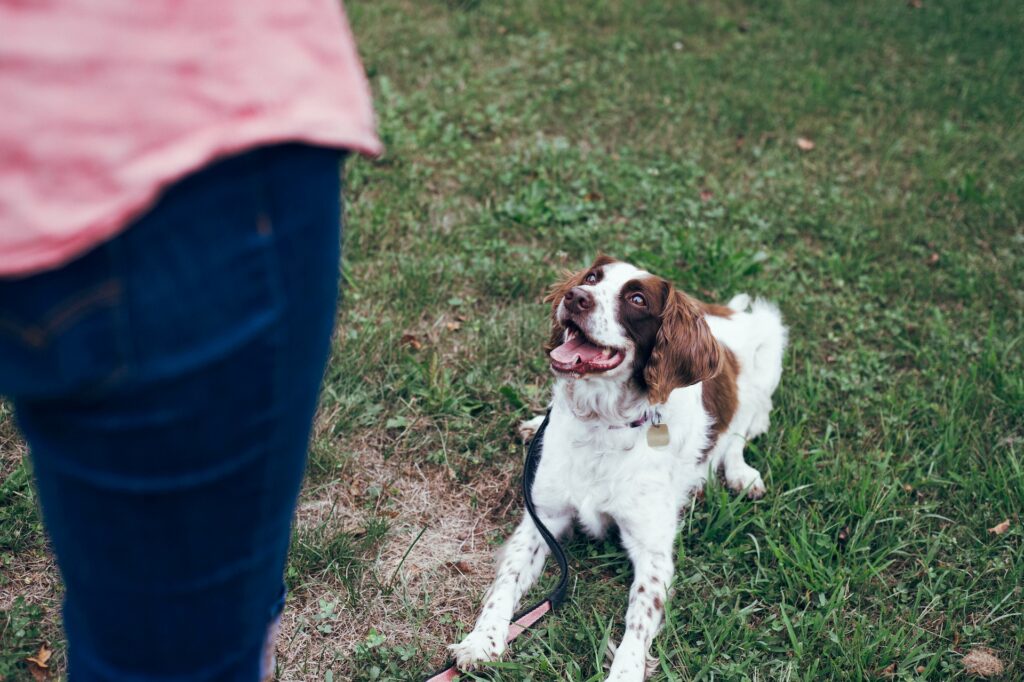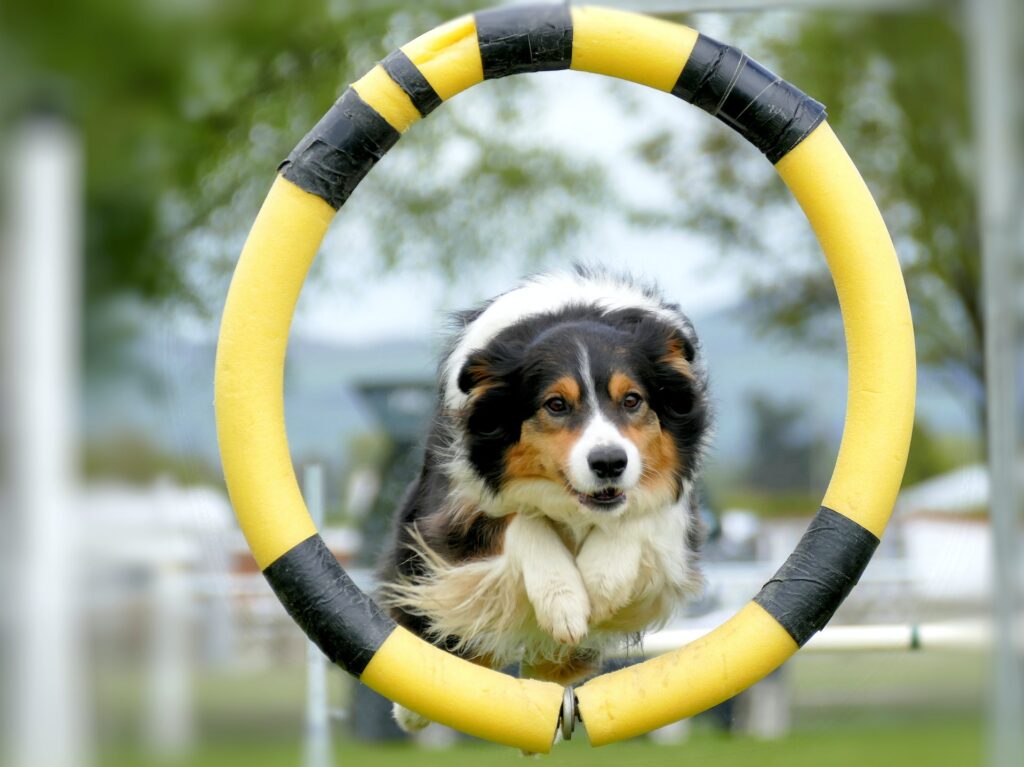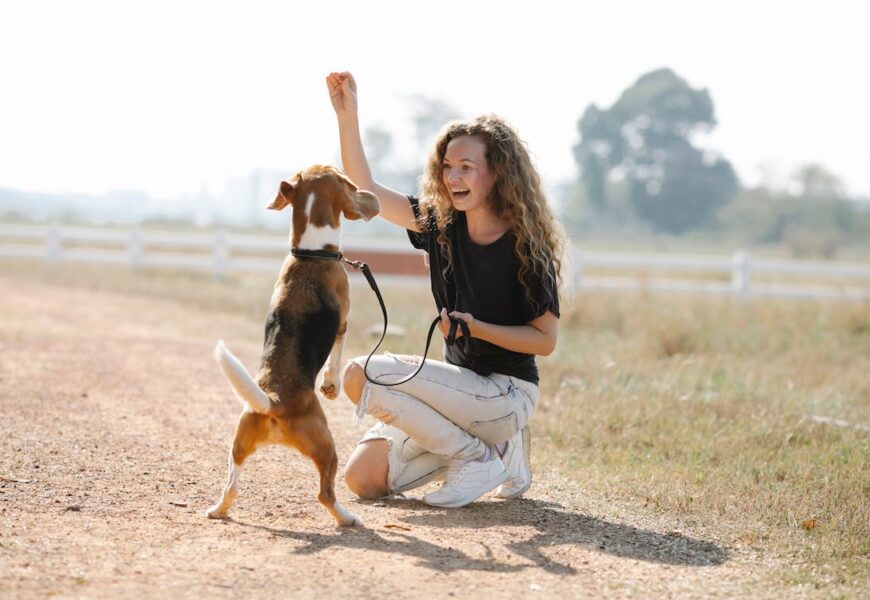“Unleash the Potential: Discover the Secrets to a Well-Behaved and Happy Canine Companion – Dog Training Tips for Obedience and Behavior Training!”
Welcoming a furry companion into your life can be an exhilarating experience. Those soulful eyes, wagging tails, and boundless energy can melt even the toughest of hearts. However, as any dog owner knows, along with the joys of pet parenthood comes the responsibility of proper training. Whether you’re a first-time owner or a seasoned dog enthusiast, the journey of teaching obedience and shaping behavior is crucial for both you and your canine friend.
This comprehensive guide delves into dog training, uncovering effective techniques for fostering obedience and addressing behavioral challenges. Training isn’t just about turning your pup into a perfectly obedient robot; it’s about forging a deeper connection with your four-legged friend based on trust, respect, and clear communication.
Our focus will revolve around two key aspects of training: obedience and behavior. The former empowers your dog to respond promptly to commands, while the latter tackles common behavioral issues that might arise during your pet’s development. With a positive and compassionate approach, we’ll explore various proven successful methods in dog training.
So, whether you’re aiming to master the art of “sit” and “stay” or seeking ways to handle separation anxiety, barking, and more, this article will equip you with the knowledge and tools to navigate the dog training world with confidence and empathy. Let’s embark on this journey together as we discover the transformative power of effective dog training in creating a harmonious and enriching bond between you and your beloved companion.
Understanding the Basics of Dog Training
The Science Behind Positive Reinforcement

At the core of successful dog training lies a powerful tool known as positive reinforcement. This science-backed technique rewards desired behaviors and encourages your furry friend to repeat them eagerly. The beauty of positive reinforcement lies in its ability to create a nurturing and enjoyable learning environment for your dog.
Imagine the delight in your pup’s eyes when they receive praise, treats, or even a gentle pat on the head for following a command correctly. By associating these rewards with specific actions, your dog begins to understand what pleases you, leading to increased motivation and a genuine eagerness to learn.
Communicating Effectively with Your Dog
While dogs might not understand human language as we do, they can comprehend and interpret our gestures, tone of voice, and body language. Effective communication forms the foundation of a strong human-canine bond and successful training.
Using clear and consistent cues, such as verbal commands and hand signals, helps your dog grasp what you expect from them. For instance, saying “sit” while simultaneously making a palm-down gesture reinforces your desired action. Remember, consistency is key—using the same cues for the same behaviors will prevent confusion and promote quicker learning.
Moreover, understanding your dog’s body language is equally crucial. Recognizing signs of stress, anxiety, or contentment allows you to adjust your training approach accordingly, ensuring a safe and comfortable environment for your beloved companion.
Obedience Training Techniques
Sit, Stay, and Come Commands

The trio of “sit,” “stay,” and “come” commands serve as the building blocks of obedience training. Teaching your dog these fundamental cues lays the groundwork for more advanced training and sets the stage for a well-behaved and attentive pet.
To teach the “sit” command, hold a treat above your dog’s head and slowly move it backward. As your pup follows the treat with its eyes, its bottom should naturally lower into a seated position. The moment they sit, say “sit” and offer the treat as a reward. Practice this repeatedly, gradually phasing out the treat and relying on praise alone.
“Stay” commands require patience and incremental progression. Begin by asking your dog to “sit” and then extend your hand, palm facing them, while firmly saying “stay.” Take a step back and, if your dog remains seated, praise and reward them. Gradually increase the distance and duration of the “stay,” rewarding successful attempts.
The “come” command ensures your dog returns to you when called, enhancing safety and control during walks or playtime. Start in a controlled environment and say “come” while gently tugging the leash toward you. When your dog approaches, offer enthusiastic praise and a treat. Practice this command frequently, varying the locations to reinforce its importance.
Loose Leash Walking
Mastering loose leash walking can turn daily walks from a tug-of-war struggle into an enjoyable and stress-free activity for you and your dog. Encouraging your canine companion to walk beside you without pulling requires patience and consistent training.
Begin by rewarding your dog for walking close to you without tension on the leash. As soon as they pull, stop walking and wait for them to return to your side. Once they do, reward them and continue. Consistency is key; avoid yanking the leash or allowing pulling to avoid reinforcing the unwanted behavior.
Incorporating positive reinforcement, such as treats or praise, when your dog maintains a loose leash will motivate them to repeat the behavior. Over time, they will learn that walking calmly by your side yields a more pleasant experience than pulling ahead.
Leave It and Drop It Commands
“Dropped food” disasters and the occasional “leave it” command can save your furry friend from potential hazards. Teaching your dog to “leave it” involves patience and impulse control.
Begin by holding a treat and showing it to your dog. As they show interest, firmly say “leave it” and close your hand. Wait a few seconds before offering a different treat as a reward for complying. Gradually increase the duration before allowing them to have the treatment.
The “drop it” command is handy when your dog grabs something it shouldn’t. Offer a high-value treat as a trade for the item in their mouth, saying “drop it” in a calm yet assertive tone. As they release the object, praise them enthusiastically and reward them with the offered treat.
Understanding the Basics of Dog Training: The Science Behind Positive Reinforcement and Effective Communication

Dog training is not merely a process of teaching commands; it is an artful dance of mutual understanding and trust between humans and their canine companions. In this segment of our comprehensive guide, we delve into the heart of successful dog training, focusing on the power of positive reinforcement and effective communication.
The Science Behind Positive Reinforcement
Positive reinforcement is a fundamental and scientifically-proven training method that taps into a dog’s instincts and desire to please. At its core, this technique involves rewarding desired behaviors to encourage repetition. Through rewards and praise, dogs are motivated to learn and respond to commands enthusiastically and joyfully.
When you reward your dog for responding to a cue, whether sitting, staying, or coming when called, you create a positive association with the action. Your pet begins to associate the behavior with pleasant experiences, such as receiving treats or hearing words of encouragement, making them more likely to comply willingly in the future.
The benefits of positive reinforcement extend beyond just shaping behavior. This technique fosters a positive and nurturing training environment, promoting a strong bond between you and your furry friend. By emphasizing positive interactions, trust is built, and fear-based training methods, which can lead to anxious or aggressive behavior, are avoided.
Furthermore, positive reinforcement can boost your dog’s confidence and self-esteem. As they master various commands and receive praise for their accomplishments, they become more self-assured and eager to learn new things. This sense of achievement enhances their overall well-being and strengthens the human-canine relationship.
Communicating Effectively with Your Dog
Clear and consistent communication is the key to successful dog training. Dogs are wise, relying on cues beyond verbal commands to interpret and understand human intent. To effectively communicate with your dog, consider the following aspects:
Importance of Clear and Consistent Communication:
Dogs thrive in an environment with predictable and reliable cues. When teaching new commands or addressing behavioral issues, consistency is paramount. Use the same verbal cues and hand signals each time you request a specific action. Avoid using multiple phrases or gestures for the same behavior, which can confuse your pet and cause slow learning.
Additionally, consistency extends to the entire household. Ensure all family members or caregivers use the same cues and training methods, promoting a unified approach to your dog’s education.
Using Verbal Cues and Hand Signals:
Combining verbal cues with corresponding hand signals reinforces the command’s meaning and helps your dog comprehend what you expect from them. For example, saying “sit” while simultaneously raising your hand palm-up will reinforce the action.
Pairing verbal cues with hand signals from the beginning of training is essential to establish strong associations. Over time, your dog will become adept at understanding both forms of communication, allowing for seamless interactions.
Understanding Your Dog’s Body Language:
Communication is a two-way street; understanding your dog’s body language is vital in gauging their emotional state and needs. Dogs communicate primarily through body posture, facial expressions, and tail and ear positions.
For instance, a wagging tail might indicate excitement or happiness, while a tucked tail could signal fear or anxiety. By paying close attention to your dog’s nonverbal cues, you can gauge their comfort level during training sessions and adjust accordingly.
Learning to read your dog’s body language helps you tailor your training approach and strengthens the emotional bond between you and your pet. It demonstrates your attentiveness and sensitivity to their feelings, promoting trust and cooperation.
Incorporating positive reinforcement and effective communication into your dog training endeavors lays the foundation for a fulfilling and harmonious relationship with your canine companion. Embrace patience, consistency, and empathy as you embark on this journey of understanding and connection with your beloved furry friend. With each step, you’ll witness the growth of your dog’s obedience and behavior and the blossoming of an unbreakable bond built on love and mutual respect.
Obedience Training Techniques: Mastering Sit, Stay, Come, Loose Leash Walking, Leave It, and Drop It Commands

As a responsible dog owner, obedience training is one of the most essential investments you can make in your canine companion’s development. In this segment of our comprehensive guide, we explore various obedience training techniques that will lay the groundwork for a well-mannered and obedient dog. From mastering the sit, stay, and come commands to achieving loose leash walking and impulse control through the leave it and drop it commands, we’ve got you covered with step-by-step instructions and practical applications for daily life.
Sit, Stay, and Come Commands
The trio of sit, stay, and come commands form the cornerstone of obedience training, enabling you to establish a strong foundation for effective communication with your furry friend.
Step-by-Step Guide to Teaching the Sit Command:
- Begin in a quiet and distraction-free environment. Hold a treat close to your dog’s nose, allowing them to smell it without grabbing it.
- Slowly raise the treat above their head, causing their nose to follow it upwards. As their nose goes up, their bottom should naturally lower into a seated position.
- The moment they sit, say “sit” in a clear and positive tone and offer the treat as a reward. Remember to praise them enthusiastically as well.
- Practice this exercise multiple times daily, gradually phasing out treats and relying on praise and physical affection to reinforce the command.
- Establishing a Reliable Stay Command:
Begin with your dog in a sitting position. Hold your hand, palm facing them, in front of their face, and say “stay” calmly yet firmly.
Take a step back. If your dog maintains the sitting position, return to them and reward with treats and praise.
Gradually increase the distance and duration of the stay, always rewarding your dog for successful attempts.
Practice the stay command in various situations and locations, slowly introducing distractions to build their ability to remain focused.
Training Your Dog to Come When Called:
Start in a controlled environment with minimal distractions. Crouch down and open your arms, encouraging your dog to approach you.
When they respond and approach, praise them enthusiastically and offer a high-value treat as a reward.
Use their name followed by the “come” command to signal their return to you. Always maintain a positive and welcoming tone to encourage compliance.
Practice this command regularly, incorporating it into playtime and off-leash activities. Avoid using the “come” command for negative reasons to ensure your dog associates it with positivity.
Loose Leash Walking
Leash manners during walks are essential for both your dog’s safety and your enjoyment of the outing. Achieving loose leash walking requires patience and consistency, but the rewards are well worth the effort.
Importance of Leash Manners for Walks:
Loose leash walking promotes a comfortable and stress-free experience for you and your dog during walks.
It allows your pet to explore its surroundings while remaining under control, reducing the risk of accidents or injuries.
Techniques to Encourage Loose Leash Walking:
Use a standard leash, avoiding retractable leashes that can encourage pulling behavior.
Walk steadily, avoiding sudden stops or changes in direction that may confuse your dog.
When your dog starts to pull, stop walking and wait for them to return to your side. Reward them with praise or treats when they do so.
Consider using a front-clip harness or head collar to discourage pulling, but ensure it is fitted properly and does not cause discomfort.
Addressing Common Challenges During Walks:
If your dog becomes overly excited or reactive during walks, practice impulse control exercises at home and gradually introduce distractions during walks.
If your dog is fearful or anxious, work on building their confidence through positive reinforcement and gradually exposing them to new environments.
Leave It and Drop It Commands
Teaching your dog to leave it and drop it can save them from potential hazards and prevent unwanted behaviors during daily activities.
Teaching the Leave It Command for Impulse Control:
Hold a treat in your hand, allowing your dog to see and smell it without taking it.
Firmly say “leave it” and close your hand. Wait a few seconds before offering a different treat as a reward for complying.
Practice with various objects and gradually increase the difficulty level.
Once your dog understands the command, apply it to real-life scenarios, such as when they show interest in food or non-edible items during walks.
Training Your Dog to Drop Items on Command:
Begin by playing with your dog and offering them a toy. As they hold onto it, say “drop it” calmly but assertively.
Offer a high-value treat as a trade for the toy. When they release the item, praise them enthusiastically and reward them with the treat.
Practice this exercise regularly, incorporating different toys and objects to reinforce the command’s application in everyday life.
Practical Applications for These Commands in Daily Life:
The leave it command can be used when your dog is tempted to eat food dropped on the floor, encounter potentially harmful items during walks, or show interest in something they shouldn’t.
The drop it command is valuable when your dog picks up an item that might be dangerous or inappropriate, ensuring their safety and preventing unwanted chewing or ingestion.
In conclusion, obedience training techniques, such as mastering the sit, stay, come, loose leash walking, leave it, and drop it commands, are essential for fostering a well-behaved and attentive canine companion. Embrace patience, consistency, and positive reinforcement as you guide your dog through their training journey. With dedication and love, you’ll witness the transformation of your furry friend into a well-mannered and happy companion, enriching both your lives with a harmonious and rewarding bond.
Behavior Training Techniques: Nurturing a Happy and Well-Balanced Canine Companion

As devoted dog owners, we understand that every dog has unique personality quirks and behavioral patterns. This section of our comprehensive guide explores behavior training techniques designed to address common challenges that may arise in your dog’s development. From understanding separation anxiety and dealing with excessive barking to addressing destructive chewing, digging, fear, and aggression, we will equip you with the knowledge and tools to foster a harmonious and positive relationship with your furry friend.
Understanding Separation Anxiety in Dogs
Dogs are social animals with a strong attachment to their human companions. Separation anxiety is a common behavioral issue in which a dog becomes distressed and anxious when left alone. Understanding and addressing this condition is crucial for your pet’s well-being.
Creating a Safe and Comfortable Environment:
Designate a cozy and inviting area for your dog to stay when you are away. This could be a comfortable crate or a special spot with their bed and toys.
Leave your dog with familiar scents, such as a recently worn shirt, to provide comfort in your absence.
Provide engaging toys or puzzle feeders to keep them mentally stimulated while alone.
Gradual Desensitization Techniques for Alone Time:
Start with short periods of separation and gradually increase the time as your dog becomes more comfortable.
Practice leaving and returning multiple times throughout the day, avoiding dramatic entrances and exits to avoid reinforcing the anxiety.
Reward your dog with treats and praise for calm behavior during your absence.
Dealing with Barking and Excessive Vocalization
Barking is a natural form of communication for dogs, but excessive vocalization can become problematic and disrupt harmony in your household. Understanding the reasons behind excessive barking is the first step in addressing this behavior.
Identifying the Reasons Behind Excessive Barking:
Dogs may bark to express excitement, fear, and boredom or alert you of potential intruders or unfamiliar noises.
Attention-seeking barking can also develop when dogs learn that barking gets them the attention they crave.
Teaching the “Quiet” Command:
Wait for a break in barking before saying “quiet” in a calm but assertive tone.
Reward your dog with treats and praise when they stop barking. Gradually increase the duration of quiet behavior before offering rewards.
Positive Approaches to Minimize Barking Behavior:
Provide plenty of physical and mental exercise to keep your dog engaged and prevent boredom-related barking.
Use gradual exposure and positive reinforcement to sensitize your dog to triggers that cause excessive barking.
Addressing Destructive Chewing and Digging
Chewing and digging are instinctual behaviors in dogs, but they can lead to destructive habits if not appropriately managed.
Redirecting Destructive Chewing Behaviors:
Offer a variety of chew toys that are safe and appropriate for your dog’s size and breed.
When you catch your dog chewing on something, they shouldn’t, redirect their attention to an approved chew toy and praise them for choosing it.
Preventing Boredom and Providing Mental Stimulation:
Engage your dog in interactive games, puzzle toys, and training sessions to provide mental enrichment.
Rotate toys regularly to keep them interesting and novel for your pet.
Tips for Managing Digging Tendencies:
Designate a specific digging area in your yard where it is acceptable for your dog to dig.
Provide ample physical and mental exercise to reduce excess energy that may lead to digging.
Handling Fear and Aggression
Fear and aggression are complex behavioral issues that require careful management and professional guidance.
Recognizing Fear and Aggression Triggers:
Pay attention to your dog’s body language and vocal cues to identify signs of fear or aggression.
Record triggers that elicit fearful or aggressive behavior to assist in training and management.
Working with a Professional Trainer for Behavioral Issues:
Seek the help of a certified professional dog trainer or behaviorist to develop a tailored training plan.
Training should focus on desensitization and counterconditioning to help your dog cope with fear and aggression triggers.
Implementing Desensitization and Counterconditioning Techniques:
Gradually expose your dog to fear-inducing stimuli at a distance they can handle without reacting fearfully or aggressively.
Pair these exposures with positive experiences, such as treats and praise, to change their emotional response to the trigger.
Conclusion
Dog training extends beyond teaching commands; it fosters clear communication and mutual understanding between owners and their beloved pets. Obedience training not only ensures that our dogs respond promptly to commands like “sit,” “stay,” and “come,” but it also empowers them to become well-behaved and attentive companions in various situations. Moreover, behavior training techniques address common challenges, such as separation anxiety, excessive barking, destructive chewing, digging tendencies, fear, and aggression, enhancing the overall well-being of our furry friends and promoting harmony within our households.
Dogs, like humans, require time to learn and adapt to new behaviors, and owners need to exhibit understanding and patience throughout the process. Consistency in training methods, cues, and expectations establishes clear boundaries and reinforces the desired behaviors in our dogs.
Moreover, positive reinforcement emerges as a powerful and compassionate training technique that motivates our furry friends to learn willingly and eagerly. By using rewards, praise, and affection as incentives for desired behaviors, we create a positive and nurturing training environment that builds trust and strengthens the bond between owner and pet.
While dog training may present challenges, the rewards of a well-trained and well-behaved canine companion are immeasurable. Investing time and effort in training ensures that our furry friends become happy, confident, and balanced members of our families. The training journey is not just about shaping their behaviors; it is a journey of growth and learning for both owners and dogs.








